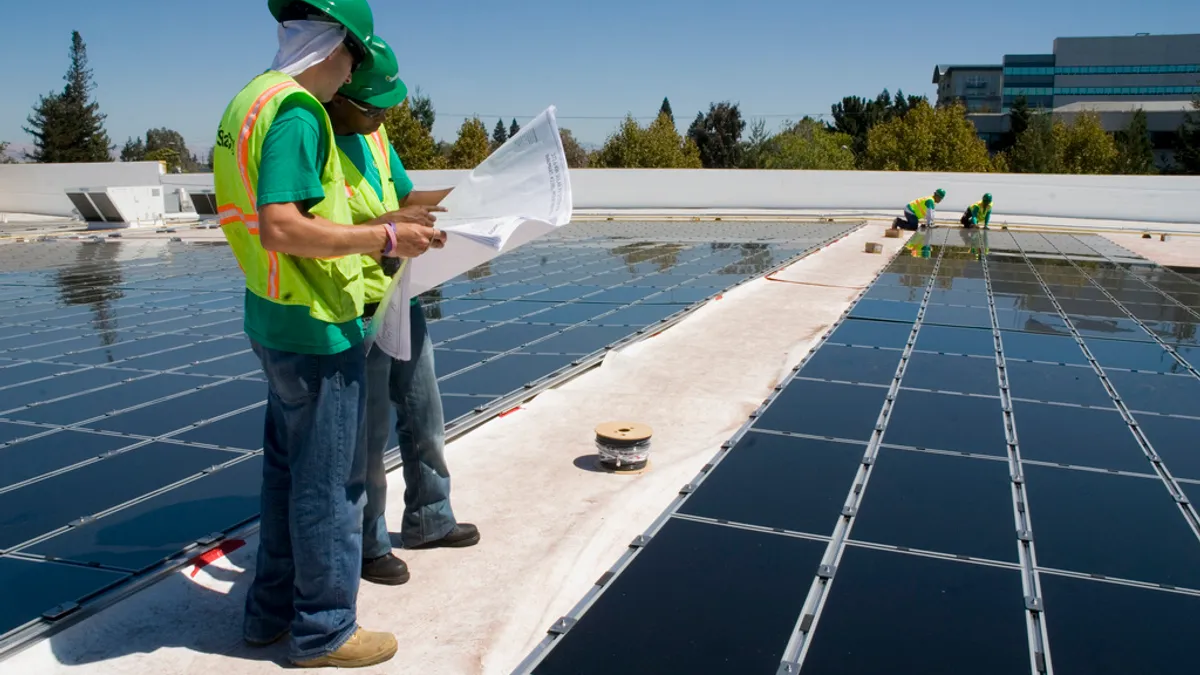SolarCity, the country's biggest installer and financier of rooftop solar, made its name by pioneering a third-party ownership model that drove the rooftop solar market to become one of the most disruptive forces in the utility industry.
What made the model so successful was that consumers could go solar and save money without paying anything down. Under the model, the solar company usually installs, owns and operates the solar system, and the customer signs either a lease for the system or a power purchasing agreement (PPA) for the power it produces. With a typical PPA for rooftop solar, the customer pays for every kilowatt-hour produced by the panels—almost always at a rate below the local utility’s.
But there are signs that SolarCity is moving away from the model that made it so successful.
What you need to know about SolarCity's new loan product
Last week, SolarCity announced it will offer a new way for consumers to go solar—loans.
“Once consumers understand it, they should prefer this product over a PPA,” SolarCity CEO Lyndon Rive told Bloomberg. “The total savings is greater than with a PPA.”
SolarCity expects that loans will make up half of its business by the middle of next year, according to Rive. That's ambitious—“especially given their guidance for next year, which is enormous,” Nicole Litvak, solar analyst at GTM Research, told Utility Dive in an interview.
SolarCity is not alone. Many of the big players in the residential solar space, including NRG Energy, SunPower, Sunrun, SunEdison, Mosaic and Clean Power Finance, already offer or will soon offer loan options. Currently, Vivint is the only major solar company that doesn't have or isn't planning to come out with a loan option, according to Greentech Media.
“What’s happened over the past year or so is we’ve started to see more of these loan products pop up,” Litvak said. “SolarCity needed to be able to compete with them and stay ahead of the curve."
But SolarCity's loan product is not just any other loan—SolarCity's new loan product looks like "the product that SolarCity is already offering," Litvak said.
To calculate the loan, SolarCity starts with the cost of the system plus interest, then estimates the output of the solar system over 30 years, Litvak said. SolarCity uses those figures to estimate the loan cost per kilowatt-hour -- which is the rate it then charges customers for the energy generated by the system.
"The customer just pays for the production of the system," Litvak said.
Solar loans are typically paid back through a fixed monthly rate, but customers who sign up for SolarCity's new loan product will pay per kilowatt-hour of actual production—much like the company's PPA product. The loan is "structured to really feel like you just have a PPA. You’re paying per kilowatt-hour," Litvak said. "SolarCity is kind of taking on the risk of any systems underperforming."
"You only pay for the energy," Rive told GTM. "If the system's not working, you're not paying."
SolarCity is making some (arguably aggressive) assumptions. The company appears to be banking on the fact that these systems will, on average, hit their expected production over the 30-year period. “I don’t know how big of a risk it’s actually going to end up being," Litvak said. "They seem pretty confident in their estimates.”
Then again, no one has ever accused SolarCity of lacking in confidence.
"Our motivation is exactly aligned with the customer," Rive said. "If a system is not performing, we have to go and make sure it's performing."
Is the market is moving away from third-party ownership?
Solar loan products are becoming more prevalent because the cost of solar has fallen dramatically over the last few years, making ownership of solar more accessible to consumers.
And when a customer buys their system, they can tap into one of the biggest incentives for solar in the U.S.—the 30% investment tax credit.
In most cases, customers are going to see a better return on their solar investment with a loan as opposed to a lease, Litvak noted. “If you add up all those lease payments, it’s going to come out to a lot more than just purchasing a system outright.”
But "if you don't have tax capacity, then the PPA or lease is a better product," Rive said.
Earlier this year, GTM predicted that third-party ownership will peak at a 68% share of the residential solar market in 2014. “Given [SolarCity's] announcement, we’re even more confident in this prediction,” Litvak said.
GTM expects third-party ownership's share of the residential solar market to fall over the next couple years. Starting next year, “loans are really going to start to take off,” she said.
“Right now, a lot of [solar companies with loan products] are still in the early stages of raising funds and figuring out how to enter the market and how to expand,” she said. “But starting next year, I think we’re going to see a lot more cash sales of solar compared to leases.”
But the big question for everyone is 2017. The 30% investment tax credit expires at the end of 2016 and could push the rooftop solar market into a state of uncertainty.
Leasing may even pick back up after 2016, Litvak posited.
While the tax credit expires entirely for residential systems—it “drops from 30% to 10% for commercial systems—but that actually includes leased residential system because it’s technically a company that owns them,” Litvak noted.























